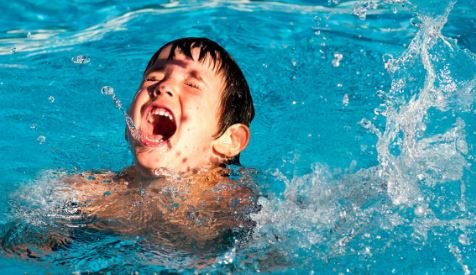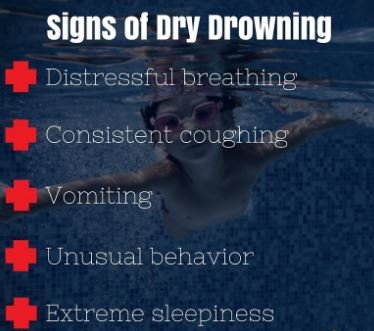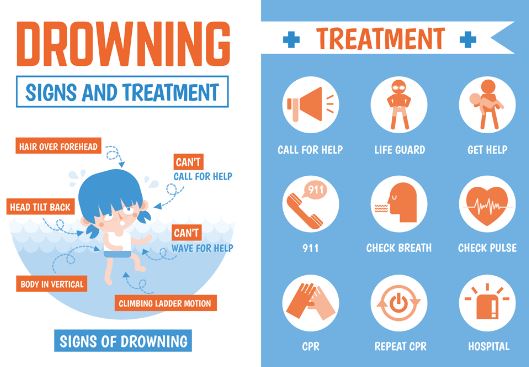If you are a parent, you have heard about “dry drowning” and other terms like “secondary drowning”, and as the names suggest, they are a form of drowning, but this time, though it starts in the waters, it is experienced after getting out of the water. Probably, what you may be asking is, “How can someone drown when they are out of the water?” Well, this article will examine closely what dry drowning is and how different it is from secondary drowning, terms that are sometimes interchangeably used to refer to drowning occurring outside of the waters.

Let’s say this, a child seems fine after getting out of a swimming pool, but an hour or so, or after about 24 hours, they begin to have trouble breathing.
What’s Dry Drowning?
Drowning is defined as having trouble breathing when water gets into the airways. It can happen while you or your child is swimming or bathing. Drowning can be fatal, but with the right timely help, you can survive it. The term “dry drowning” just like “secondary drowning” isn’t proper medical term. They are terms used to describe rare complications that occur when a child or adult has been in a pool or water. 1
With dry drowning, water does not reach the lungs, but instead there is spasm or closing up of a person’s vocal cords because of breathing in water. The breathing in water makes the airways to shut off making it difficult for the child or person to breathe. You may begin to notice the signs right away, but it can take may be up to an hour.
Another drowning complication is the “secondary drowning” in which case, water gets into the victim’s lungs. This causes the lining of the lungs to irritate. It can also cause fluid to build up resulting in a condition referred to as pulmonary edema1. Again, with “secondary drowning” you may likely notice the victim having trouble breathing soon after they are out of the water, however, it can become worse over time, say the next 24 hours. 1,2,3
While both complications are rate, making up about 1 to 2 percent of all drowning cases, according1 to James Orlowski, MD, a pediatrician of Florida Hospital Tampa.1
Dry drowning is also referred to as submersion injury, and so is secondary drowning, so people tend to use these terms interchangeably including experts in the medical field. However, they refer to different conditions according2 to Mark R. Zonfrillo, M.D., MSCE who is an attending physician at the Children’s Hospital of Philadelphia in the Department of Emergency Medicine.
Zonfrillo says that in dry drowning, a person will take in small amounts of water through their mouth or nose, something that causes spasm to develop in their airway, which in turn causes the airway to close up.
Dry drowning will occur soon after the victim has exited the water, probably within an hour. In secondary drowning, the victim takes little bits of water that pass to enter the lungs resulting in an inflammation or swelling. This in turn makes it difficult for the victim’s body to transfer oxygen or carbon dioxide. In secondary drowning, it can delay for up to 24 hours before a person shows the signs. Both of these complications cause trouble breathing, they can even result in death.2
How Common is Dry Drowning?
These are rare incidents, and although they can be incredibly terrifying, when you know what to do, you can manage them. Only about 1 to 2 percent of all drowning incidents are regarded as “dry drowning” and “secondary drowning” or in broader term, submersion injuries. There may be no specific stats to show how many children die each year from dry drowning or secondary drowning, but Kathleen Berchelmann, M.D who is a pediatrician serving at Washington University School of Medicine and St. Louis Children’s Hospital says the numbers are very few.2
In the 12 years Berchelmann has been working as a pediatrician, she has only seen one single patient who had drowning, which had happened long after they had gotten out of the pool. Berchelmann further points out that although it was an isolated incident, it was surely a life threatening scenario. Parents and children spending time in pools, oceans, and lakes, especially during the summer should take extra precautions.2
How Do You Spot Dry Drowning?
While dry drowning and secondary drowning may be life threatening and are rare to happen, the good news is that, there will be some warning signs. You may want to look out for:
- Persistent coughing after having been on water or coughing that comes when a child has to breathe more
- A person having rapid shallow breathing and nostril flaring. Sometimes, when the child breathes, you can see the dent in between the ribs. You may also be able to see a gap appearing above the child’s collarbone while she or he breathes. These are signs that she or he is working hard to breathe.
- A child that has been pulled from water in a water rescue may need immediate medical attention to prevent dry drowning or secondary drowning
- If a child appears sleepy, but she has all along been excited during the time she or he was in the pool, this may be a sign of fatigue and it may mean that there isn’t sufficient oxygen that is circulating in the blood. Medical attention is needed immediately.
- Vomiting after having been in water may be a sign of having stress due to something like an inflammation or lack of oxygen. It could also happen because of persistent gaggling and coughing.
- Change in behavior where a child shows forgetfulness. This may happen if there is reduced level of oxygen in body that causes the child to be woozy or feel sick.
Symptoms & Signs of Dry Drowning

A person or kid likely to be having dry drowning will show symptoms such as:
- Coughing
- Trouble breathing
- Chest pain
- Feeling extremely tired or fatigued
Treatment of Dry Drowning

It will depend on the symptoms the patient is experiencing and how severe they are. A doctor examines the child and checks the oxygen levels as well as their breathing patterns. If the symptoms are mild, the child may only require careful observation.
In serious cases, X-ray may be done on the chest to examine the complications. Oxygen may be given.
If there is respiratory failure where a child cannot breath, they may need to be put on a ventilator or breathing tube. A ventilator helps promote blood flow in lungs, it helps the victim to regain their breathe.
The Bottom Line
You are accompanying your child to the swimming and have paid all the attention. No single moment you left her or him, you made sure that there was a lifeguard to assist. That’s surely what is required of you whenever your kid is swimming or in the water. However, that doesn’t mean he or she is all safe. After coming out of the water and he or she seems okay, you also want to look for suspicious signs of having dry drowning or secondary drowning.
Reference List
- What Is ‘Dry Drowning’? Available at https://www.webmd.com/children/features/secondary-drowning-dry-drowning#1
- Dry Drowning: Know the Signs. Available at https://www.parents.com/kids/safety/outdoor/dry-drowning/
- Dry drowning and secondary drowning: How to spot them and prevent them. Available at https://www.today.com/parents/dry-drowning-secondary-drowning-know-warning-signs-t112457
- What You Need to Know about Dry Drowning. Available at http://www.parenting.com/child/safety/what-you-need-to-know-about-dry-drowning
- What parents need to know about ‘dry drowning’. Available at https://www.popsci.com/secondary-and-dry-drowning
